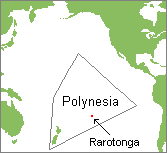Descent
Principles: Part 2
Bilateral
 , descent is
used by most people in Europe and the Americas
today. This cognatic system traces descent from all
biological ancestors regardless of their gender
and side of the family. In addition, all male
and female children are members of both their father's and mother's families.
Everyone shown in red below is a bilateral relative of ego.
, descent is
used by most people in Europe and the Americas
today. This cognatic system traces descent from all
biological ancestors regardless of their gender
and side of the family. In addition, all male
and female children are members of both their father's and mother's families.
Everyone shown in red below is a bilateral relative of ego.

In some societies that use bilateral descent, the
non-red people in the diagram may also be considered relatives. However, this is often a matter of
individual choice. In North America, they are referred to as in-laws and are
generally considered to be more distant kinsmen. Take
another look at the diagram above and think about who you consider to be
your relatives. Does your family follow this or one of the other
descent patterns described in the last section of the tutorial?
While there is no inherent
gender bias in the bilateral descent principle, there often is a slight male bias in
marriage practices and in the creation of families. This can be seen in North
America today when a man's last name is used by his wife and children. With this
exception, however, there usually is no other similarity with patrilineal descent.
Bilateral descent is rare
among the societies of the world, though, it is common if you count people instead
of societies.
It is characteristic of large agricultural and industrial nations as well as hunters and
gatherers in harsh, relatively nonproductive environments such as deserts and arctic
wastelands. It is also found among some transhumance
 pastoralists living in poor environments.
pastoralists living in poor environments.
How Many Relatives do you
have?
The specific type of descent
system employed has a major effect on the number of people who are recognized as
ancestors. With unilineal descent,
there is only one direct ancestor in each generation. However, with
bilateral descent, there is a doubling of
ancestors with each generation further back in time.
ANCESTRAL
GENERATION |
NUMBER OF DIRECT
ANCESTORS |
|
Unilineal |
Bilineal |
Bilateral |
|
1 |
1 |
2 |
2 |
|
2 |
1 |
2 |
4 |
|
3 |
1 |
2 |
8 |
|
4 |
1 |
2 |
16 |
|
5 |
1 |
2 |
32 |
|
6 |
1 |
2 |
64 |
Given the fact that bilateral
descent results in many ancestors in just a few generations, it is not surprising that
few people in North America know the names of all eight of their great grandparents, let
alone the names of their sixteen great great grandparents.
 |
A large bilateral
family in North America |
By comparison, it is not
unusual for people who use unilineal descent systems to remember all of their ancestors for five or more
generations. In fact, some Polynesians from the island of Rarotonga in the early
20th century knew the names of their ancestors back 90 or more generations.
In
fairness, however, it should be noted that the people of Rarotonga traditionally have had
more of an ancestor focus than do most people in North America today. This
difference in focus may have as much to do with their respective economies and pace of
life as with their kinship systems.
One further trait of bilateral
descent deserves mention. Families using this system have a potential for
recognizing
far more collateral
 descendants than would
those using one of the unilineal patterns. This is not due to producing more
offspring but to having descent lines continued by both male and female children every
generation.
descendants than would
those using one of the unilineal patterns. This is not due to producing more
offspring but to having descent lines continued by both male and female children every
generation.
Summary
You have learned that the
two principle ways people around the world trace descent are
unilineal and
cognatic
(or nonlineal).
Unilineal descent recognizes
only a single line of ancestors through males or
females. It occurs in two forms--patrilineal,
which follows the male line,
and
matrilineal,
which follows the female line. The patrilineal form is more common.
With cognatic descent, both the mother's and the father's ancestors to some
degree are considered to be within the family line. Cognatic descent
occurs in four forms--bilineal,
parallel, ambilineal,
and bilateral descent.
|
GENERAL RULE
|
SPECIFIC RULE |
|
unilineal descent |
patrilineal descent |
|
matrilinal descent |
|
cognatic descent |
bilineal descent
|
|
parallel descent |
|
ambilineal descent |
|
bilateral descent |
One final caution is in
order. People do not always follow their culture's descent principles
precisely. Kinship is often manipulated. For instance, people may create or
deny links to particular ancestors in order to make their genealogy come out to their
advantage. In addition, kinship systems are changing
rapidly today as societies are increasingly exposed to other cultures around
the world and new kinds of economies.
This page was last updated on
Friday, March 16, 2007.
Copyright © 1997-2007 by Dennis O'Neil.
All rights reserved.
Illustration credits
![]() , descent is
used by most people in Europe and the Americas
today. This cognatic system traces descent from all
biological ancestors regardless of their gender
and side of the family. In addition, all male
and female children are members of both their father's and mother's families.
Everyone shown in red below is a bilateral relative of ego.
, descent is
used by most people in Europe and the Americas
today. This cognatic system traces descent from all
biological ancestors regardless of their gender
and side of the family. In addition, all male
and female children are members of both their father's and mother's families.
Everyone shown in red below is a bilateral relative of ego.

